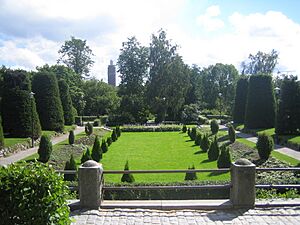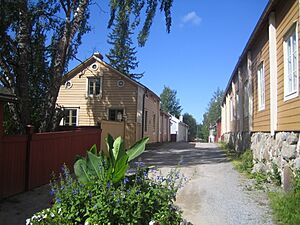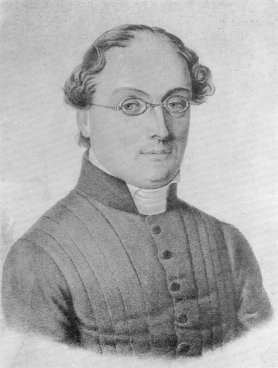Jakobstad facts for kids
Quick facts for kids
Jakobstad
Pietarsaari
|
|||
|---|---|---|---|
|
Town
|
|||
| City of Jakobstad Staden Jakobstad Pietarsaaren kaupunki |
|||
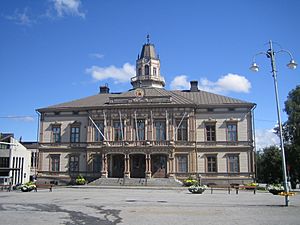
The old Town Hall
|
|||
|
|||
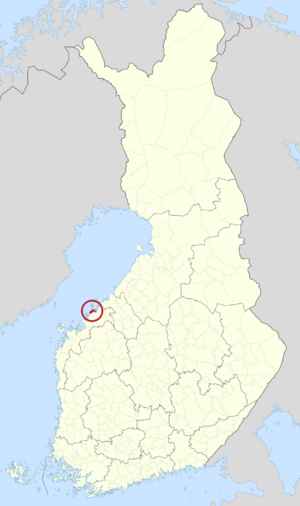
Location of Jakobstad in Finland
|
|||
| Country | |||
| Region | Ostrobothnia | ||
| Sub-region | Jakobstad sub-region | ||
| Charter | 1652 | ||
| Named for | Jacob De la Gardie | ||
| Area
(2018-01-01)
|
|||
| • Total | 396.35 km2 (153.03 sq mi) | ||
| • Land | 88.52 km2 (34.18 sq mi) | ||
| • Water | 307.94 km2 (118.90 sq mi) | ||
| Area rank | 302nd largest in Finland | ||
| Population
(2023-12-31)
|
|||
| • Total | 19,475 | ||
| • Rank | 60th largest in Finland | ||
| • Density | 220.01/km2 (569.8/sq mi) | ||
| Population by native language | |||
| • Swedish | 54.1% (official) | ||
| • Finnish | 31.2% | ||
| • Others | 14.7% | ||
| Population by age | |||
| • 0 to 14 | 15.5% | ||
| • 15 to 64 | 58.2% | ||
| • 65 or older | 26.3% | ||
| Time zone | UTC+02:00 (EET) | ||
| • Summer (DST) | UTC+03:00 (EEST) | ||
Jakobstad (Finland Swedish: [ˈjɑːkopˌstɑːd]) is a town in Finland. It is located on the country's west coast. Jakobstad sits in the Ostrobothnia region. It is right by the Gulf of Bothnia.
The population of Jakobstad is about 19,000 people. This makes it the 58th largest municipality in Finland. The town covers a land area of about 299 square kilometers. Neighboring towns include Larsmo, Pedersöre, and Nykarleby. The city of Vaasa is 98 kilometers southwest.
Jakobstad is a bilingual municipality. Both Finnish and Swedish are its official languages. About 30% of the people speak Finnish. Around 56% speak Swedish. The rest speak other languages.
Contents
Understanding Jakobstad's Names
The Swedish name, Jakobstad, means "Jacob's City" or "Jacob's Town". It is named after Jacob De la Gardie. The town was built at the old harbor of the Pedersöre parish. This old name lives on in the Finnish name, Pietarsaari. This means "Peter's Island".
Jakobstad's Interesting History
The town was founded in 1652 by Ebba Brahe. She was the wife of military leader Jacob De la Gardie. Queen Christina of Sweden gave Jakobstad its city rights. The town started at the old harbor of the Pedersöre parish. Pedersöre is still a separate town next to Jakobstad.
The city grew slowly at first. Wars also made growth difficult. Russian troops invaded the city twice during the Greater Wrath. Many parts of the town were burned down. Most people fled the city. Some went to Sweden, others hid in forests or islands. Many were captured or killed. In the 1720s, some people returned. Newcomers also moved in. The town finally started to grow. The current church was built in 1731.
Growing Through Trade and Industry
Jakobstad's economy grew in the mid-1700s. Making tar and packaging tobacco were important. Trade quickly grew after 1765. Cities on Finland's coast could then trade directly with other countries. This also made shipbuilding a big activity in Jakobstad. The first ships to sail abroad were the Jacobstads Wapen and the Enigheten.
Trade and shipbuilding made Jakobstad a rich city. Adolf Lindskog was a notable merchant and shipbuilder. He became one of the richest men in Finland.
The early 1800s brought big changes. There was a war between Sweden and Russia from 1808 to 1809. A terrible fire in 1835 destroyed about half the city. Despite this, the economy kept growing. A brewery, a matchstick factory, and banks were started after 1850. In 1859, Peter Malm opened a steam-powered sawmill. It was only the second one in Finland.
The Crimean War hurt the shipping industry. The British navy blocked the sea. Jakobstad's shipping fleet went from 26 ships to just 9.
The Start of Modern Industry
Important business people in the 1800s included Otto Malm and Wilhelm Schauman. Schauman started a chicory factory in Jakobstad in 1883. This is seen as the start of modern industry in Jakobstad. By 1900, the Strengberg tobacco factory was the biggest employer.
The city changed from a shipping city to an industrial city. From 1850 to 1900, the population grew a lot. It went from about 1,500 to over 6,000 people. Factories grew quickly and new ones opened. The city made many things, from beer to matches. More Finnish-speaking people moved to the city. This happened because the tobacco factory needed many workers.
During World War II, Soviet planes bombed the city once. This caused some injuries. Until the 1960s, Jakobstad was small. Most people spoke Swedish. But industry grew in the 1960s and 1970s. This brought many Finnish-speaking workers. The city became almost majority Finnish-speaking.
Fun Events in Jakobstad
At the end of July, the Jakobsdagar event takes place. It lasts for a whole week. It includes concerts, market stalls, and performances. Many people visit each year. The name "Jakobsdagar" means "Jacob's days." It refers to the city's name.
At the end of November, there is a music festival called Rusk. It features great chamber music and other arts. The main place for events is the Schauman Hall. But events also happen around the city.
Culture and Sights to Explore
- Jakobstad City Hall is a historic building. It was finished in 1875. Its current look is from 1890.
- Jakobstad is home to the galeas Jacobstads Wapen. This is a full-size copy of a ship from 1755. It was built between 1987 and 1992.
- Jakobstad - Pietarsaari Museum is the main museum. It focuses on the city's sea and shipbuilding history.
- The Arctic museum Nanoq is just outside Jakobstad.
- Cikoriamuseet was Finland's only chicory museum. It is in an old chicory factory. You can learn how chicory was made there. You can also see how old factories worked. The museum also has art shows.
- The botanical garden Skolparken is known for its many plants. It has about 1,000 plant species. It is one of the most northern botanical gardens. It also has classic park design. The park was started in 1915 and finished in 1932. The Schauman family paid for it. They wanted to honor Elise and Viktor Schauman.
- Skata is a protected old neighborhood. It is close to the city center. It dates back to 1783. It was home to sailors and their families. Later, it became a working-class area. Many workers from the Strengberg tobacco factory lived there.
- Pedersöre Church is also in the area.
Local Food and Restaurants
In the 1980s, a local liverwurst became a traditional food of Jakobstad. The city has many cafés and restaurants. The Strengberg tobacco factory was the first in Finland to offer lunch to its workers. Jakobstad has many types of restaurants. These include ethnic restaurants, home-cooked lunch spots, and fine dining. There are also cafés, pubs, and nightclubs.
Sports Teams in Jakobstad
The town's football team, FF Jaro, plays in Ykkösliiga. This is the second highest league in Finland. Another team, Jakobstads BK, plays in Kakkonen. The women's football club, FC United, has been very successful.
Jakobstad's Twin Towns
Jakobstad is connected with other cities around the world. These are called twin towns or sister cities.
Notable People from Jakobstad
Many famous people come from Jakobstad.
- Alexei Eremenko Jr., a footballer.
- Roman Eremenko, also a footballer.
- Sara Forsberg, a singer, actress, and comedian.
- Bertel Jung, an architect and city planner.
- Mathias "Vreth" Lillmåns, singer for the band Finntroll.
- Karl and his son Walter Nars, important business owners.
- Fredrik Norrena, an ice-hockey goalkeeper.
- Jens Portin, a footballer.
- Jonas Portin, also a footballer.
- Fredrika Runeberg, a writer.
- Johan Ludvig Runeberg, Finland's national poet. He wrote the national anthem.
- Tomas Sandström, an ice-hockey player.
- Ossian Schauman, who started the organization Folkhälsan.
- Magnus Schjerfbeck, an architect.
- Simon Skrabb, a footballer.
- Philip Ulric Strengberg, a major businessman. He owned the local tobacco factory.
- Heidi Sundblad-Halme, a composer. She started the Helsinki Women's Orchestra.
Images for kids
See also
 In Spanish: Jakobstad para niños
In Spanish: Jakobstad para niños




